When Life Has Other Plans
A spine surgeon’s journey with quadriplegia

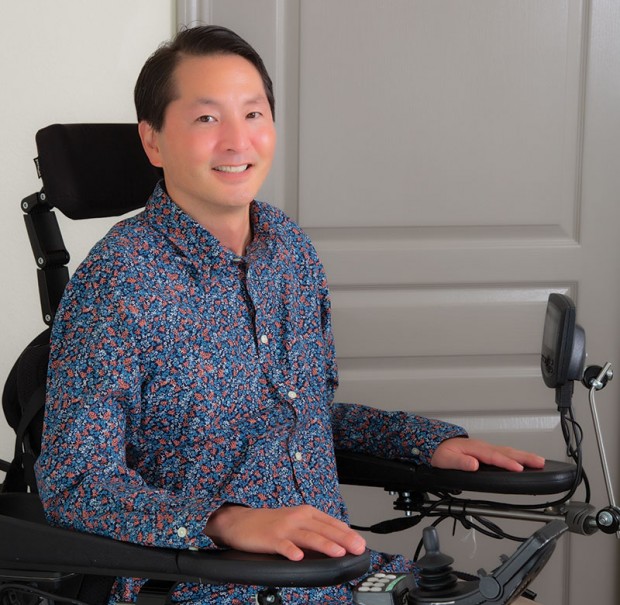
DOCTOR AS PATIENT World-renowned spine surgeon Rex Marco, paralyzed in a mountain-biking accident, navigates a different world now. “Life has a plan for me,” he says. (Photo: lawellphoto.com)
In the shadow of the Bayou City, trails snake through a latticework of elms, oaks and loblolly pines. Up and down, they meander, past prickly vines and hollies, overseeing rain-forged ravines. Tree roots invade the paths like giant arthritic fingers, knobby and gnarled.
Mountain bikers take to the Orange Trail in Memorial Park for its winding curves and dips, a welcome break from Houston’s flatness. Rex Marco would be one of them this hot, sunny day, 14 months ago.
But first, there was work to do.
The world-renowned spine surgeon and musculoskeletal oncologist from Houston Methodist Hospital had recently excised a patient’s tumor from their cervical spine, whole, leaving the spinal cord unscathed. That afternoon, he met with his research coordinator to transcribe a medical narrative about the case.
“After work was finished, I was really excited for my ride,” recalls Marco, 55, who joined mountain bikers from the 12-step recovery group, Cornerstone Team Counseling, most Sundays. The outings were a salve for the senses. He knew the stress and heartache of watching loved ones struggle. The program taught him to meditate and practice mindfulness to de-stress and clear mental clutter.
“When you feel like the world is falling apart, you get out there, and all you think about is what's 20 feet in front of you and how many roots there are. It’s a very mindful activity,” says friend David Hanson, who biked with the doctor that day.
The group played “no dabs,” riding without putting a foot down for balance. For each dab, bikers would do a pushup at trail’s end. Honor-system rules. “I loved pushups, but I also didn’t want to put my feet down,” Marco says.
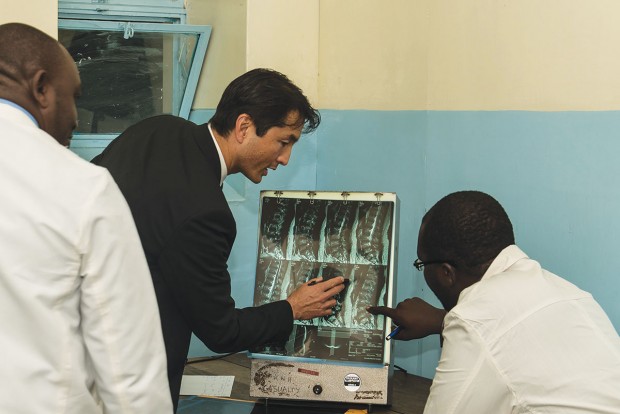
Surgeons in Kenya benefited from Dr. Rex Marco’s expertise during his mission trip there a few years ago. Here, they look over a patient’s films.
At a fork in the trail, the doctor turned left to avoid a branch. His tire stuck – on what, he doesn’t know – hurling him over the handlebars. “It happened so fast. I heard a crack. I wasn’t sure if it was from my helmet or my neck.”
Hanson, an engineer, arrived at the same fork, noticing a straight-line object glinting from a wooded slope: handlebars. He then saw a bike seat. Feet. Pant cuffs. He knew it was Marco. The methodical surgeon wore long pants and sleeves to avoid scratches from brush.
He clambered down the slope to a brambly patch to get to him. “He was basically just dangling there, held up by branches and little trees. If not for the bramble of stuff, he would have slid down the side. He could have gone a long way.”
Calmly, but in full doctor mode, Marco instructed Hanson how to support his neck until help arrived. He asked him to touch his hands and feet, see if they were moving.
“Are you touching them?”
“Yes, I’m touching them.”
The doctor’s voice grew weak, his breathing more labored. A wave of radical acceptance washed over him.
“I knew I had broken my neck, and I was paralyzed,” he says. “It was important to accept that. There was no turning back.”
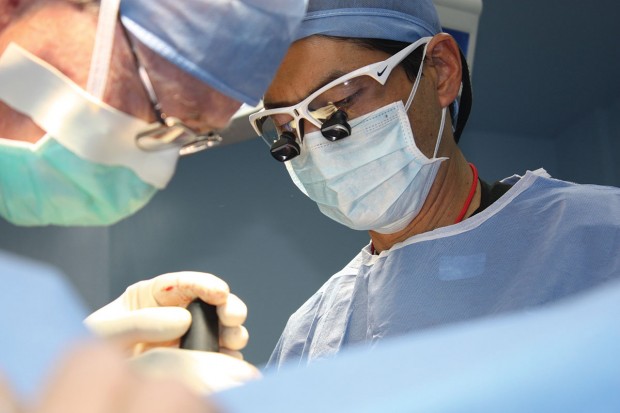
Rex Marco and fellow spine surgeon Chip Davis operate in Guatemala during a volunteer mission trip with the Christian non-profit group, Faith In Practice. (Photo: Faith In Practice)
The spinal cord is a delicate bundle of nerve fibers that transmit messages from the brain to the rest of the body and back, regulating sensory, motor and autonomic function. The higher the injury to the vertebral column, the more function is affected. The doctor knew time was critical.
“As soon as David touched me, and I couldn’t feel, I knew I probably would never hold my unborn baby,” says the father to four sons whose infant is now 1 year old.
He instructed Hanson to call his ex-wife – in the day of cell phone memory dials, the only full number he could remember. By speaker phone, he informed her there’d been an accident. Please call his physician assistant Jerry Buchert, he said. Tell him to call David Hanson’s number.
July 21 of last year, 7 p.m. It was Buchert’s birthday. He called Hanson’s number. He remembers the punch of Marco’s words.
“He said ‘Jerry, I’m a quadriplegic. My neurologic function is out. I need you to call Dr. Prasarn and see if he will take care of me.’ And they said that the ambulance had been called.”
Within two hours, he was undergoing surgery at Houston’s Memorial Hermann Hospital, surgeon Mark Prasarn at the helm. “We were partners together about eight years ago. He was one of the first people I thought of to help me,” explains Marco, who reviewed his own x-rays, consulting on the surgical plan to stabilize his spine.
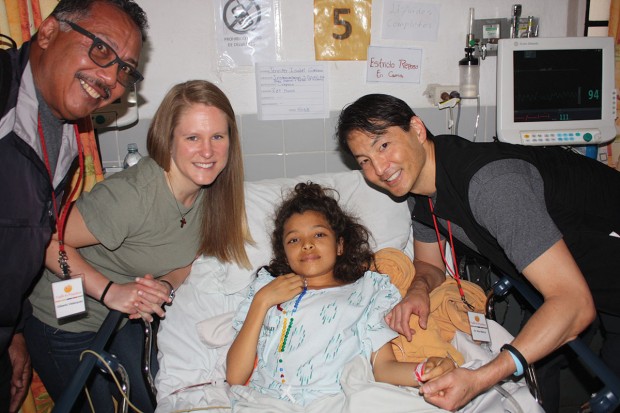
Marco (right), interpreter Gilberto “Gil” Velazquez and physical therapist Ashley Trautschold tend to a patient in Guatemala. (Photo: Faith In Practice)
For Buchert, his physician assistant of 16 years, the evening was a blur of activity, calling friends, colleagues. They gathered at the hospital, waiting, hoping to wake from what surely was a nightmare.
“It’s still a shock to a lot of his patients who come in for a yearly follow-up on their tumor or spine and haven’t heard what happened to him. Almost everyone cries,” says Buchert, who was trained by Marco. The pair have performed countless surgeries together, including trips to Kenya and earthquake-ravaged Haiti, helping patients with catastrophic spine and neck injuries.
“Mindfulness was a major part of his practice in recent years,” Buchert continues. “He would talk about it with patients who had chronic degenerative problems, but didn’t want to have them. The problem is, there’s not a fix to some of those things to make them totally go away. And screws and rods don’t necessarily just change your life for the better immediately, as you can imagine.”
Dr. Marco sits in a wheelchair in his apartment, not far from Houston’s Texas Medical Center (TMC) reflecting on his surgical career. Prior to the accident, it was at its peak. As one of only a handful of surgeons in the world with expertise in complex spinal disorders and musculoskeletal tumors, he treated patients with the worst of medical maladies.
He draws strength from them.
“I clearly have a totally different understanding of how difficult and devastating this injury is, how quadriplegia and paraplegia affect you,” he says, recalling months on a ventilator when panic gripped like a vice.
Surgeons had performed a tracheostomy as access-way for the ventilator to do its job. Breathe for him. He was on the machine for nearly three months till respiratory muscles gained strength. His condition mandated a two-week stay in critical care, then rehabilitation at Memorial Hermann’s TIRR until Nov. 6.
“In the past, if I was feeling fear or anxiety, I’d take deep breaths until it went away. But I couldn’t breathe after the accident,” he says. “Life took my breath away.”
So, he would meditate and pray. “I’d stop, try to breathe, try to smell, listen, taste and feel what I could. It helped me.”
In medical terms, Marco is an incomplete quadriplegic. He can’t move his arms and legs, but has regained some feeling in his hands and feet, fingers and toes. His right bicep muscle flickers. His back muscles sometimes twitch. He can feel pain. “I’m grateful to feel pain.”
While happy for the sensation he’s gained, walking again is not likely this far out from the accident, he says. “In my experience, I’ve never seen anyone walk again if they don’t gain a lot of motion within six months.” His eyes well up when recalling his mom, Lily, at the hospital. “I’ve never seen her cry. I’ve seen her sad. But not crying. She cried that day.”
The catastrophic nature of Marco’s injury brings enormous expense. He requires 24-hour care, approximately $150,000 a year. And certain necessities are called for when a patient’s arms and legs no longer work.
Thanks to a February fundraiser and other donations, he’s now in a “standing” wheelchair that allows him to slowly angle from sitting to standing position. The benefits are many, he explains. He can load-bear bones, strengthening them. He operates it by chin to a foam-tipped joystick. The chair can be programmed to help him control his television, computer mouse and cell phone.
The wheelchair also allows for better weight-shifting, preventing bedsores and helping lung function and digestion. Violent, involuntary leg spasms that jolted him awake at night have decreased since getting the chair, too.
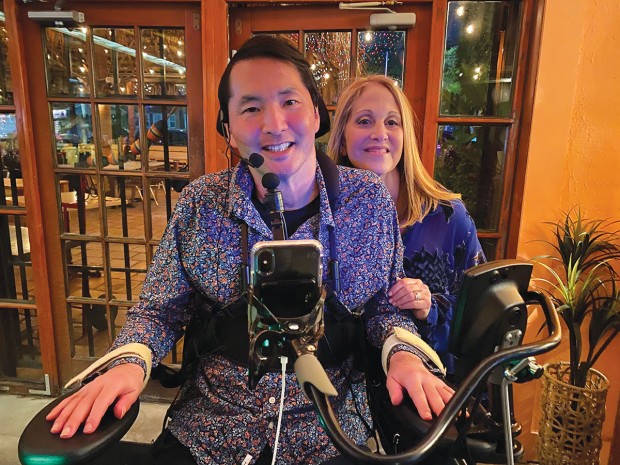
Friends and colleagues packed a fundraiser in February to show support for the doctor. Organizer Yvonne Spolane is all smiles with Marco.
He will soon receive a robotic arm that attaches to the chair, assisting in personal grooming tasks, eating, grabbing things. “Maybe walking a dog.”
He’s hoping for a service dog one day. And he’s waiting for modifications to be completed on a home he purchased in Highland Village. A one-story, close to TMC.
“The fundraiser in February was a packed house,” says organizer Yvonne Spolane, a former operating-room nurse at Texas Children’s Hospital who has worked with Marco. “There’s a lot of things he needs, and insurance doesn’t cover a lot of things. But every time I see him, he’s upbeat. He’s amazing. Driven.”
It surprises no one that Marco is back doing work while quarantining during the Covid-19 pandemic. He’s nothing if not driven, say colleagues.
“Why me?” doesn’t cross his mind. Life has a plan, the doctor says. “I know there’s a plan for me. I don’t clearly know what it is yet, but I’m getting more clarity.”
“We do bi-monthly conferences in which we do case studies, and Rex had been coming to those in his wheelchair before the pandemic,” says spine surgeon Christoph Meyer, a faculty member with the TMC Spine Fellowship, a training program Marco founded 18 years ago to train physicians as specialists in spine surgery.
“Here he is a year out, totally dependent on other people, yet giving talks, continuing research projects. We had a research symposium back in June of this year, and he had his name on three papers, I think. He’s not giving up, and he never will give up.”
Not an option, says Marco, who is eager to get back to clinic one day, seeing patients. He’d also like to help in some capacity with the Christopher & Dana Reeve Foundation, supporting its mission to find cures for spinal cord injuries.
“For me, Rex is larger than life. It was hard to adjust to the thought of him being a quadriplegic. But he’s the same person,” says Adrianne Morse, who did a residency in orthopedic surgery years ago, Marco as her mentor. “He’s always been strong of mind. It’s crazy when you think about the horrible irony of all of it.”
He no doubt will continue to accomplish great things, says the Rev. Linda McCarty, president and CEO of Faith in Practice, a Christian non-profit that brings medical, surgical, dental and other health-related services to the poor of Guatemala.
“We treat the whole person, not just the body. It’s not just your hands, it’s your heart. Rex has a unique specialty, but he also has a very special heart. He was a natural fit for us,” she says of the doctor who had become a team leader for the group. Before the accident, he’d been organizing another Guatemala trip.
She recalls something his mother said at the hospital. “She said, ‘God has always done beautiful and wonderful things through Rex, and I know that’s going to continue to be the case.’ And she’s right.”
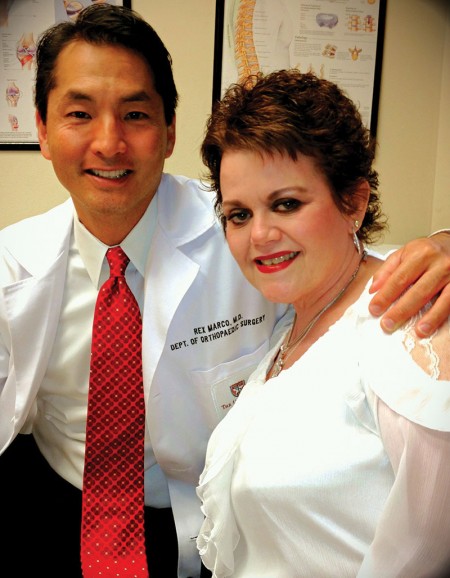
Rhonda Johnson, nine years cancer-free, credits the surgeon with saving her life by amputating her leg. He surprised her by wearing red scrubs for the operation, the hue she chose as her “positive energy color.” He wore a red tie for all her office visits. (Photo: Roland Johnson)
Rhonda Johnson thinks back to a time when she put her life in Marco’s hands. A cancerous tumor in her right pelvic floor had destroyed her hip socket, causing 52 hairline fractures. It could not be treated or replaced. Marco proffered two surgery options. One was a hemipelvectomy, the removal of her leg, hip and half her pelvis. She’d have less of a chance of recurrence with that option. But he sent her home to contemplate. She met him a week later with her decision. Amputation.
The day of surgery, she was surprised to find that the doctor had gone out and purchased red scrubs, the “positive energy color” she chose to get her through her cancer battle. During chemotherapy treatments, prior to ever meeting the doctor, she’d taken a red blanket to chemotherapy treatments; clipped a short, red hair extension as bangs to her head scarves and hats. “He heard about it and wore those scrubs for me. And in all my office visits with him, he’d be wearing a red tie. That’s the kind of compassion he has.”
She spoke at the February fundraiser, Marco beaming.
“I wanted him to know that we are all there for him,” Johnson says. “He saw me through it. I’ll see him through this. I’ll never forget what he told me when I said I wanted him to take my leg. He hugged me and said, ‘I would only hope that if something happened like this to me, I could be as brave and strong and courageous as you.’”
Marco remembers that conversation. But most of all, her courage.
“It inspired me throughout my career,” he says. “Especially now.”
Editor’s note: To donate to the BCI Charitable Relief Fund benefiting Rex Marco, see teambcirelieffund.org/rex-marco.
Want more buzz like this? Sign up for our Morning Buzz emails.
To leave a comment, please log in or create an account with The Buzz Magazines, Disqus, Facebook, or Twitter. Or you may post as a guest.


